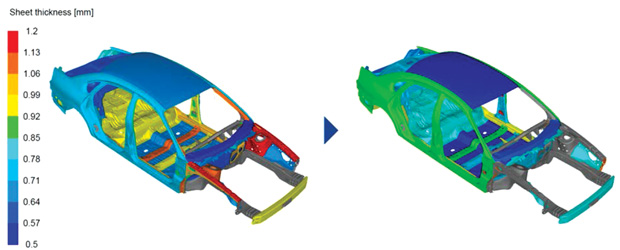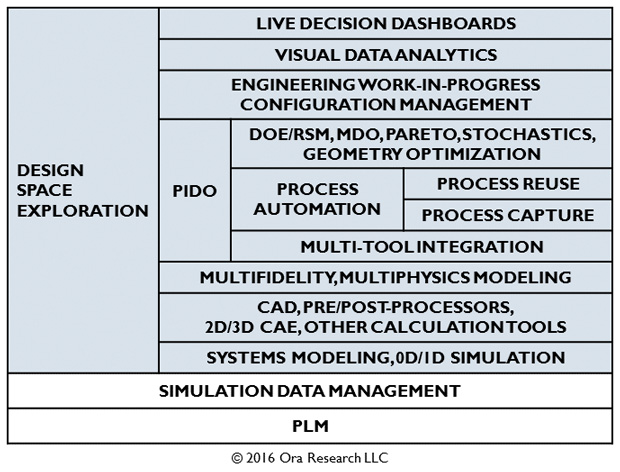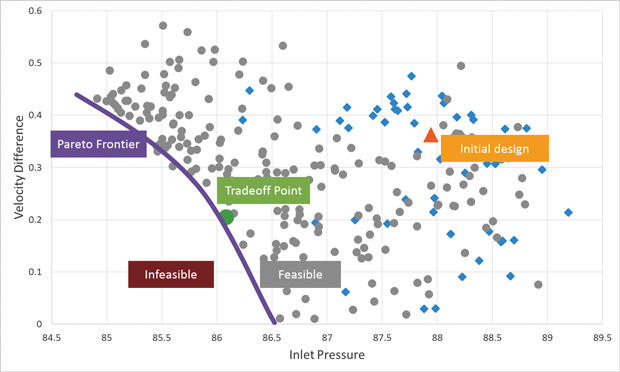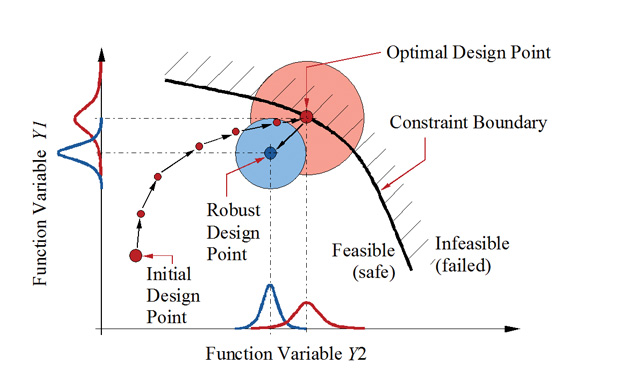
Size optimization with Tosca Structure done on a vehicle model developed by The National Crash Analysis Center (NCAC) of The George Washington University under a contract with the FHWA and NHTSA of the U.S. Dept. of Transportation. Image courtesy of Dassault Systèmes.
December 1, 2016
 Size optimization with Tosca Structure done on a vehicle model developed by The National Crash Analysis Center (NCAC) of The George Washington University under a contract with the FHWA and NHTSA of the U.S. Dept. of Transportation. Image courtesy of Dassault Systèmes.
Size optimization with Tosca Structure done on a vehicle model developed by The National Crash Analysis Center (NCAC) of The George Washington University under a contract with the FHWA and NHTSA of the U.S. Dept. of Transportation. Image courtesy of Dassault Systèmes.Design space exploration and design optimization software tools let engineers systematically and automatically investigate very large numbers of design alternatives to identify those with the most optimal performance parameters. Many of the quantitative and algorithmic methods that underpin design exploration and optimization have been long known—and sometimes applied—in cases where the attendant costs in expertise, time and labor could be justified. What’s changing now is the way that fresh software technologies are transforming these powerful but formerly difficult-to-apply methods into practical, everyday engineering aids.
Reaching Functional Maturity
Many design exploration and optimization software products originated as solutions for a comparatively narrow set of user requirements. Some focused on a specific application such as multidisciplinary design optimization. Others began as environments for integrating customers’ existing simulation software tools then building on those chained data flows to automate the setup and execution of analysis and optimization problems. Over time, most evolved to offer all the primary functions of design exploration/optimization software environments—design of experiments and various kinds of optimization, supported by simulation process automation and multi-tool integration.
Faster Implementation from Off-the-Shelf Integration
Design exploration and optimization software typically works by exercising digital product models and simulation/analysis solver codes across a range of parameter values and defined functional conditions to characterize and optimize the performance of a design. Adoption of the technology was long hampered by the difficulty of integrating it with user organizations’ existing modeling, simulation and analysis tools. Indeed, the expense of developing those integrations on a custom basis, and the consequent long, slow implementation cycles, soured many early adopters on the experience in the 1990s and early 2000s. Accordingly, today’s software vendors make it a point to offer off-the-shelf integration with as many product modeling environments and simulation/analysis codes as their development budgets will allow, often presenting their list of ready-to-go integrations as a key selling point.
Making design space exploration software speak the language of engineers instead of mathematicians has been a focus of development since the industry’s inception. Fortunately for practitioners, developers have made great strides on this front in the past handful of years. Parameter tuning, manual selection of statistical search methods and other problem setup requirements that long made the tools intimidating to learn and painful to use are today being minimized and even almost eliminated. They are being replaced by increasingly capable and intelligent software aids that let engineers characterize design problems in more natural ways, then have the software select appropriate settings and solution algorithms. New developments in self-adapting solution search techniques are delivering still more progress on this front.
Foundations in PIDO: Process Integration and Design Optimization
Design space exploration as an engineering formalism originated in the embedded systems industry as a set of methodologies for hardware/software co-design, configuration of software product lines and real-time software synthesis. In mechanical engineering, design space exploration is rooted in the technological domain often referred to as process integration and design optimization (PIDO) first identified and defined in 2001 (by this article’s author) as software and methods that help automate and manage the setup and execution of digital simulation and analysis tasks; coordinate and integrate simulation results from multiple disciplines and domains to produce a more holistic virtual model of product performance; and optimize one or more aspects of the design by iterating analyses across a range of parameter values toward specified target conditions while observing defined problem constraints.
 Current capabilities of design optimization and design space exploration. Image courtesy of Ora Research.
Current capabilities of design optimization and design space exploration. Image courtesy of Ora Research.Core capabilities of today’s commercial software offerings in this domain typically include:
- Design of experiments (DOE)
- Response surface modeling (RSM)
- Design optimization
- Geometry optimization
- Parameter optimization
- Multidisciplinary optimization (MDO)
- Multi-objective (Pareto) optimization
- Robustness-and-reliability (stochastic) optimization
- Systems-level optimization
- Process automation
- Multi-tool integration
Design of Experiments (DOE)
Design of experiments (DOE) studies are used to predict design sensitivities and/or gain a better understanding of the design space. Their aim is to extract the maximum amount of information quickly with the least computational or experimental effort. In a DOE study, an analysis model is automatically evaluated multiple times, with the design variables set to different values in each iteration. The results identify which variable(s) affect the design the most, and which the least. This allows variables that are not important to be ignored subsequently, or set to values that are most convenient or least costly.
More specifically, a designed experiment is a structured set of tests of a system or process. Integral to a designed experiment are response(s), factor(s) and a model.
• A response is a measurable result: fuel mileage (automotive), deposition rate (semiconductor), reaction yield (chemical process).
• A factor is any variable that the experimenter judges may affect a response of interest. Common factor types include continuous (may take any value on an interval; e.g., octane rating), categorical (having a discrete number of levels; e.g., a specific company or brand) and blocking (categorical, but not generally reproducible; e.g., automobile driver-to-driver variability).
• A model is a mathematical surrogate for the system or process.
The experiment consists of exercising the model across some range of values assigned to the defined factors. In deciding what values to use—more precisely, in deciding a strategy for choosing values—the goal is to achieve coverage of the design space that yields maximum information about its characteristics with the least possible experimental (computational) effort, and with confidence that the set of points sampled gives a representative picture of the entire design space. Numerous sampling methods exist to do this. Which to use depends on the nature of the problem being studied, and on the resources available: time, computational capacity and how much is already known about the problem.
Response Surface Modeling (RSM)
The results of a DOE sampling process can be used to generate an approximate model of the system being studied, generally called a response surface model (RSM). The RSM is generated by interpolating between the discrete DOE results to create a continuous surface map or model. These models are very convenient for visualizing the design space, examining relationships among variables and their effects on key responses, and rapidly evaluating design alternatives without performing additional expensive CAE evaluations or experiments.
Design Optimization
Topology optimization is the first thing many people think of when they hear the term “optimization” in the context of engineering design. But topology optimization is just one kind of geometry optimization—and that, in turn, is only one of six broad classes of optimization technology commercially available today. (Editor’s Note: See “The Six Types of Optimization Defined” section below.)
The power of all the various numerical methods is their ability to rationally, rapidly and automatically search through large numbers of design alternatives for the best possible design(s). Parameters in a design that can be varied to search for a top design are design variables. Given these, design can be structured as the process of finding the minimum or maximum of some attribute, termed the objective function. For a design to be acceptable, it also must satisfy certain requirements, or design constraints. Optimization is the process of automatically changing the design variables to identify the minimum or maximum of the objective function while satisfying all the required design constraints.
Simulation Process Automation
The power of PIDO is grounded in chained simulation process flows, in which parameters and results from one software tool are automatically provided as inputs to another. Beyond eliminating the time and error penalties of manual data extraction and reentry, automating the manipulation and mapping of data between process steps makes it feasible to combine simulation models and applications from multiple disciplines and physical domains for a holistic model of product performance, then automate their execution across a range of values hundreds or thousands of times to explore and map the potential design space.
The Six Types of Optimization Defined
1. Geometry optimization denotes automated, software-driven optimization of a structure’s topology, shape, size, topography or topometry to satisfy operating limits imposed on the response of the structure—which response is typically calculated either by structural analysis, or by CFD analysis—and by further limits imposed on the values that the structural parameters can assume.
Topology optimization tools work by optimizing material layout within a given physical design volume, for a given set of loads and boundary conditions, so that the resulting layout meets prescribed targets for strength, stiffness and/or other performance attributes. This is often used to identify a conceptual design that best meets specified design requirements, which is then refined for performance and manufacturability. It frequently yields biomorphic-appearing shapes better suited to additive than subtractive manufacturing, requiring modification for conventional manufacturing.
Shape optimization software optimizes structural shapes by adjusting the surface shape of a 2D or 3D solid to minimize volume while satisfying stress and/or displacement constraints (generically termed a cost functional). In many cases, solving the functional consists of solving a given partial differential equation defined on the variable domain.
Size optimization applications work by modifying size-related properties of structural elements such as shell thickness, beam cross-sectional properties, spring stiffness and mass to solve the optimization problem.
Topometry optimization is similar to topology optimization but applied to 2D elements, with the variables restricted to the element-wise thicknesses.
Topography optimization, like topometry optimization, is applicable only to 2D or shell elements, and aims at finding the optimum bead pattern for a component.
2. Parameter optimization, in some respects a more generalized version of geometry optimization, is a procedure for finding values for any parameter(s) in a design—not just geometric parameters—that are optimal in some defined respect, such as minimization of a specified objective function over a defined data set.
3. Multidisciplinary optimization (MDO) incorporates all relevant disciplines—structural (linear or nonlinear, static or dynamic, bulk materials or composites), fluid, thermal, acoustic, NVH (noise, vibration and harshness), multibody dynamics, or any combination—simultaneously in an optimization problem. By exploiting interactions among different disciplines, MDO can identify design solutions that are superior to those arrived at by optimizing each discipline sequentially, and at substantially lower costs in time and labor.
4. Multi-objective (Pareto) optimization is a numerical method for addressing the fact that real-world optimization problems usually have more than one objective. In optimizing a structural design, for example, the desired design would be both lightweight and rigid. Because these two objectives conflict, a tradeoff must be made. The set of tradeoff designs that cannot be improved on according to one criterion without harming another criterion is called the Pareto set. For the example shown on the facing page, the curve plotting the best design candidates’ inlet pressure against velocity difference is the Pareto frontier.
A design is judged to be Pareto-optimal, Pareto-efficient or in the Pareto set if it is not dominated by any other design. Once the Pareto set has been identified, the action of comparing the various Pareto-optimal solutions to choose the preferred solution for the specific case under consideration is based on exogenous factors (outside the computer model), and is carried out by human decision-makers.
5. Robustness-and-reliability (stochastic) optimization tools address the reality that product designs are nominal, while manufacturing and operating conditions are real data. Finite geometric tolerances, variations in material properties, uncertainty in loading conditions and other variances encountered by a product in either production or use can cause it to perform slightly differently from its nominal, as-designed values. Therefore, robustness and reliability as design objectives beyond the nominal design are often desirable. Performance of robust and reliable designs is less affected by these expected variations, and remains at or above specified acceptable levels in all conditions.
To evaluate the robustness and reliability of a design during simulation, its variables and system inputs are made stochastic—that is, defined in terms of both a mean value and a statistical distribution function. The resulting system performance characteristics are then measured in terms of a mean value and its variance.
6. Systems-level optimization is becoming increasingly practical through integration among design exploration and optimization software applications, and systems modeling and 0D/1D simulation tools. Systems modeling software consists of tools and languages for systems engineering—the specification, analysis, design, verification and validation of systems and systems-of-systems—while 0D/1D simulation software uses the time dimension only (0D), or time plus a single spatial dimension (1D). Together, systems modeling and 0D/1D simulation are used early to make a product’s crucial high-level functional and architectural decisions.
Design Space Exploration and Design Optimization Software Vendors and Products
- Altair Engineering Inc. HyperStudy, OptiStruct, solidThinking Inspire
- ANSYS Inc. DesignXplorer, Adjoint Solver, Optimetrics
- Autodesk Inc. Inventor Shape Generator, Simulation Mechanical Design Optimization, Simulation CFD Design Study Environment, Within, Project Dreamcatcher
- CEI Inc. EnSight
- Cenaero ASBL Minamo
- Collier Research Corporation HyperSizer
- Comet Solutions Inc. SimApps, SimApp Authoring Workspace
- COMSOL Inc. Multiphysics Optimization Module
- Concepts NREC TurboOPT II
- DATADVANCE LLC pSeven, pSeven Core, pSeven Cloud
- DecisionVis ExplorerDV
- divis intelligent solutions GmbH ClearVu Global Optimizer
- Dynamic Design Solutions NV FEMtools Optimization
- Dynardo GmbH optiSLang
- eArtius Inc. eArtius Pareto Explorer
- ESI Group ESI MINESET Predictive Analytics Solution, Virtual Performance Solution Multi-domain Optimization, Adjoint Optimization Solver
- ESTECO s.p.a. modeFRONTIER, SOMO
- Exa Corporation PowerFLOW Optimization Solution
- FEA-Opt Technology Co. Ltd. SmartDO
- FINNOPT Oy FINNOPT Platform
- FRIENDSHIP SYSTEMS AG CAESES
- FunctionBay, Inc. RecurDyn/AutoDesign
- Gamma Technologies LLC GT-SUITE DOE Design Tool, DOE-POST, Optimization Algorithms
- iChrome Ltd. Nexus
- InModelia Neuro Pex
- INTES GmbH PERMAS-OPT, PERMAS-TOPO
- LIONlab LIONsolver
- LSTC LS-OPT
- Maplesoft Maple Optimization Package
- MathWorks Simulink Design Optimization
- MSC Software Corporation MSC Nastran Multi-run & Design Space Exploration, MSC Nastran Design Optimization
- NASA Glenn Research Center OpenMDAO
- NISA Software CSIL NISAOPT
- Noesis Solutions NV Optimus, id8
- nTopology Inc. Element
- Optimal Solutions Software, LLC Sculptor
- OptiY GmbH OptiY
- Phoenix Integration, Inc. ModelCenter Integrate, ModelCenter Explore, ModelCenter Organize
- PIDOTECH, Inc. PIAnO
- POLOPT Technologies GmbH POLOPT/Optim
- PTC Creo BMX (Behavioral Modeling Extension)
- Quint Corporation OPTISHAPE-TS
- RAMDO Solutions LLC RAMDO (Reliability Analysis & Multidisciplinary Design Optimization)
- RBF Morph RBF Morph
- Sandia National Laboratories Dakota
- SciArt, LLC CloudTopOpt, ParetoWorks
- Siemens PLM Software, Inc. Geometry Optimization, FE Parameter Optimization, LMS Amesim Design Exploration, STAR-CCM+ /Enabling Optimate, STAR-CCM+ /Enabling Optimate+, HEEDS MDO, HEEDS NP, HEEDS POST
- Sigma Technology IOSO
- SIMULIA (Dassault Systèmes SIMULIA Corp.) Isight, Tosca Structure, Simulation Process & Optimization (SPI)
- SmartUQ LLC SmartUQ
- SOLIDWORKS (Dassault Systèmes SOLIDWORKS Corp.) SOLIDWORKS Simulation Structural Optimization
- TechnoSoft Inc. Adaptive Modeling Language (AML)
- Tecplot Inc. Tecplot Chorus
- Vanderplaats Research & Development Inc. GENESIS, DOT, BIGDOT, VisualDOC
- Virtual.PYXIS GmbH Virtual.PYXIS
— This list is representative but not exhaustive. HEEDS MDO, HEEDS NP, HEEDS POST was accidentally edited out of the author’s original submission. The editors regret the omission.
Subscribe to our FREE magazine, FREE email newsletters or both!
About the Author
Bruce Jenkins is president of Ora Research (oraresearch.com), a research and advisory services firm focused on technology business strategy for 21st-century engineering practice.
Follow DE







